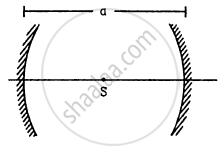Advertisements
Advertisements
Question
A 3 cm tall object is placed at a distance of 7.5 cm from a convex mirror of focal length 6 cm. Find the location, size and nature of the image.
Solution
Given,
Height of the object AB, h1 = 3 cm
Distance of the object from the convex mirror, u = −7.5 cm
Focal length of the convex mirror (f) = 6 cm
Using mirror formula,
\[\frac{1}{v} + \frac{1}{u} = \frac{1}{f}\]
\[ \Rightarrow \frac{1}{v} = \frac{1}{f} - \frac{1}{u}\]
Putting values according to sign convention,
\[\frac{1}{v} = \frac{1}{6} - \frac{1}{( - 7 . 5)}\]
\[\frac{1}{v} = \frac{1}{6} + \frac{1}{7 . 5} = \frac{3}{10}\]
Magnification = m = \[- \frac{v}{u} = \frac{10}{7 . 5 \times 3}\]
\[\Rightarrow \frac{A'B'}{AB} = \frac{10}{7 . 5 \times 3}\]
\[ \Rightarrow A'B' = \frac{100}{75} = \frac{4}{3} = 1 . 33 \text{ cm }\]
Where A'B' is the height of the image.
Hence, the required location of the image is \[\frac{10}{3} \text{ cm }\] from the pole and image height is 1.33 cm. Nature of the image is virtual and erect.
APPEARS IN
RELATED QUESTIONS
Fill in the blank:
Very fine particles mainly scatter ………… colored light.
Draw the intensity distribution for the fringes produced in interference ?
Write two points of difference between the phenomena of interference and diffraction.
What is linearly polarized light?
Suppose you are inside the water in a swimming pool near an edge. A friends is standing on the edge. Do you find your friend taller or shorter than his usual height?
The image formed by a concave mirror
A thin lens is made with a material having refractive index
\[\mu = 1 \cdot 5\]. Both the side are convex. It is dipped in water \[\mu = 1 \cdot 33\]. It will behave like
A point object O is placed on the principal axis of a convex lens of focal length f = 20 cm at a distance of 40 cm to the left of it. The diameter of the lens is 10 cm. An eye is placed 60 cm to right of the lens and a distance h below the principal axis. The maximum value of h to see the image is
A concave mirror having a radius of curvature 40 cm is placed in front of an illuminated point source at a distance of 30 cm from it. Find the location of the image.
A concave mirror has a focal length of 20 cm. Find the position or positions of an object for which the image-size is double of the object-size.
A point source S is placed midway between two converging mirrors having equal focal length f as shown in figure. Find the values of d for which only one image is formed.
One end of a cylindrical glass rod (μ = 1.5) of radius 1.0 cm is rounded in the shape of a hemisphere. The rod is immersed in water (μ = 4/3) and an object is placed in the water along the axis of the rod at a distance of 8.0 cm from the rounded edge. Locate the image of the object.
A paperweight in the form of a hemisphere of radius 3.0 cm is used to hold down a printed page. An observer looks at the page vertically through the paperweight. At what height above the page will the printed letters near the centre appear to the observer?
Explain: ‘How is a rainbow formed’?
Answer the following question in detail.
Explain the formation of a primary rainbow. For which angular range with the horizontal is it visible?
Rainbow is the phenomenon due to ______.
| Case study: Mirage in deserts |
 |
|
To a distant observer, the light appears to be coming from somewhere below the ground. The observer naturally assumes that light is being reflected from the ground, say, by a pool of water near the tall object. Such inverted images of distant tall objects cause an optical illusion to the observer. This phenomenon is called mirage. This type of mirage is especially common in hot deserts. Based on the above facts, answer the following question : |
In an optical fibre, if n1 and n2 are the refractive indices of the core and cladding, then which among the following, would be a correct equation?
The sky would appear red instead of blue if
